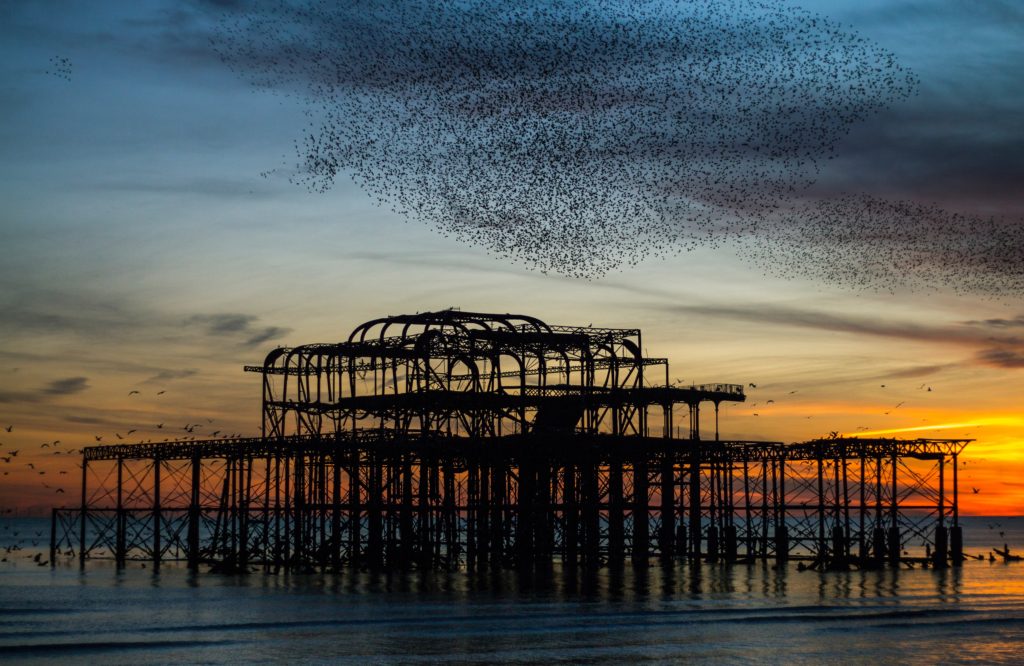What words can do justice to the magic of a million birds, flying and weaving as one? Improvisatory choreography? Elegant chaos? Symphonic cacophony?
There is no familiar way to make sense of this natural phenomenon — both what starlings do and how they make us feel when we see them. Yet the flocking behavior of the birds the ancient Romans believed foretold the will of the Gods — indeed, the word auspicious comes from the Latin auspicium, or “divination by observing the flight of birds” — is a natural manifestation of a set of principles for organizing complex behavior, and an observable phenomenon that runs counter to the way we human beings have made sense of the world for as long as anyone can remember.
Starlings are native to several continents, although North America is not one of them. Back in 1890, however, a Shakespeare enthusiast decided that all birds mentioned in Shakespeare’s plays should be brought to North America (the starling makes its star turn in Henry IV, Part 1). His idea worked — a little too well. From an initial group of 100 birds, the starling population in North America now tops 200 million. And it is the behavior of each bird in those massive, undulating flocks that makes the starling so notable — and, for some, so magical.
Almost a century ago, the British ornithologist Edmund Selous asserted that these “handsome, lively, vivacious birds” were telepathic. Today, the biologist Rupert Sheldrake suggests that starling behavior is an example of his hypothesis of morphic resonance, or the notion that the laws of nature are “more like habits, ones in which each individual inherits a collective memory from past members of the species, and also contributes to the collective memory, affecting other members of the species in the future.” And yet beyond these appreciations and speculations, we have lacked the ability to concretely explain how a murmuration works — how one million individual creatures can dart and soar in self-organizing synchrony . . . until now.
Thanks to the work of two separate studies from 2013, we now know that individual starlings all obey the same few flight rules:
Watch your seven nearest neighbors.
Fly toward each other, but don’t crowd.
And if any of your neighbors turn, turn with them.
Why do they do this? According to one of the studies, “when uncertainty in sensing is present, interacting with six or seven neighbors optimizes the balance between group cohesiveness and individual effort.”

By following this rule of seven, the birds become part of a dynamic system in which each individual part combines to make a whole with emergent properties. This collective behavior allows the birds to gather information on their surroundings and self-organize toward an ideal density, one in which optimal patterns of light and dark are produced that can deliver information to the entire flock (and protect them from predators). The closer each bird pays attention, the safer — and more cohesive — the entire flock becomes.
Of course, this sort of swarming behavior is not unique to starlings. Many different animals, from birds and insects to fish and mammals, have been observed in their own form of a swarm. So what can this behavior teach us about ourselves, our organizations, and our ability to change the story of the way we work and learn?
According to Andreas Weber, author of The Biology of Wonder, “the spirit of poetic ecology is the spirit of swarms. To understand the individual, we need to understand its environment, and each through the other. We have to think of beings always as interbeings.
“We are a swarm ourselves,” Weber writes, “and we form swarms. A swarm does not have intelligence; it is intelligence. In this respect, a swarm (or a murmuration) is an intensified counterpart of ourselves. It is what we are and what we try to imagine with our conscious thinking. Swarms are solidified feeling. The swarm is — and in its being living dynamics and their expression are welded together in one single gesture.”
In other words, a murmuration is more than just a pretty metaphor for thinking differently about organizational behavior; it’s a reminder, in physical form, that our own bodies, cultures and classrooms are governed by the same rules. As Weber puts it, “we see gestalts of the living that behave according to simple organic laws mirroring the great constellation that every living being has to cope with: to persist, to be close to the other, but not so close as to collide with him. These are the principles of poetic forms that are so thorough we can even teach them to a computer. They are the primary shapes of a poetics of living things.”





Recent Comments